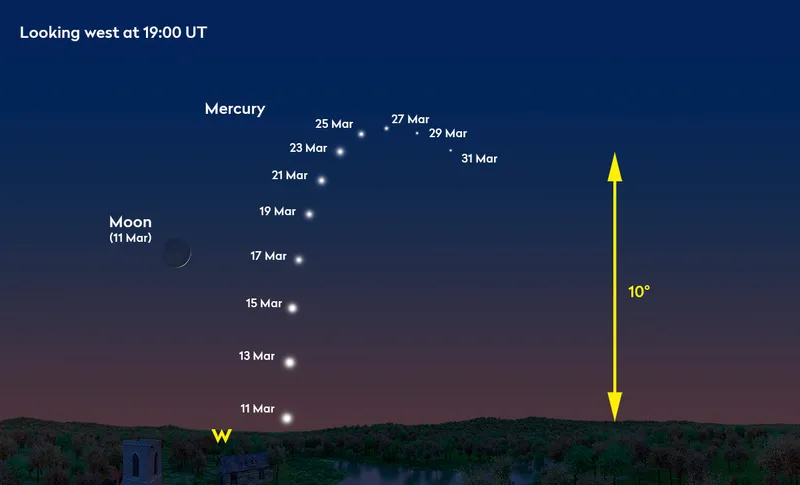In this guide we'll reveal which planets will be visible in the sky in March, and which will not be visible at all.
Mercury is probably the planet to keep an eye on, as it is set to improve throughout March 2024, although it begins the month very tricky to see.
Its improvement as the month goes on is due to the inclination of the ecliptic plane being rather steep against the western horizon at this time of year as the sun goes down.
On 7 March, Mercury shines at mag. –1.4 and sets 40 minutes after the Sun.
By 25 March Marcury will set two hours after the Sun, and even though its brightness will have decreased, you should still be able to make it out.
Find out more about Mercury in March 2024 and scroll down for our quick guide to visible planets in 2024.
Keep up to date with what's in the night sky by signing up to receive the BBC Sky at Night Magazine e-newsletter and listen to our weekly Star Diary podcast

How to see the planets in March 2024

Mercury
- Best time to see: 25 March, 40 minutes after sunset
- Altitude: 10°
- Location: Pisces
- Direction: West
- Features: Phase, surface markings
- Recommended equipment: 150mm scope or larger
Venus
- Best time to see: 1 March, 20 minutes before sunrise
- Altitude: 2° (very low)
- Location: Capricornus
- Direction: East-southeast
Venus is visible in the morning sky, but is getting trickier with each passing day. On 1 March, it shines at mag. –3.8 and rises just 40 minutes before the Sun. On this date it sits close to mag. +1.3 Mars, but this planet is rapidly lost in the bright morning sky.
Venus sits less than half a degree from mag. +0.8 Saturn on 22 March, but the pairing will be lost in the dawn twilight. By the time the end of March arrives, Venus will rise just 16 minutes before the Sun.
Mars
Mars is in the morning sky in March 2024, but is unlikely to be seen.
Jupiter
- Best time to see: 1 March, 18:30 UT
- Altitude: 42°
- Location: Aries
- Direction: Southwest
Jupiter is slowly losing its battle against the evening twilight. On 1 March, it appears 40° up against a fairly dark sky, but by the end of the month it’s only 16° up under similar darkness. Despite this, Jupiter remains bright and beautiful to look at through a telescope.
On 1 March, it shines at mag. –2.0, dimming slightly to mag. –1.9 by the end of the month. A 16%-illuminated waxing crescent Moon will appear 3.8° from Jupiter as true darkness arrives on 13 March. The distance closes until the Moon sits 3° northwest of Jupiter as both objects approach the west-northwestern horizon around 22:30 UT.
Saturn
After lining up with the Sun in solar conjunction at the end of February 2024, Saturn is now a morning object, but it is still too close to the Sun to be seen properly.
On 22 March, it sits 26 arcminutes from mag. –3.8 Venus, but at mag. +0.8 and battling against the bright dawn twilight, Saturn is unlikely to be seen.
Uranus
- Best time to see: 1 March, 19:40 UT
- Altitude: 40°
- Location: Aries
- Direction: West-southwest
The observing window closes for Uranus this month, the evening twilight rapidly expanding to engulf the
mag. +5.8 planet. It’s visible under dark-sky conditions at the start of March, 40° above the west southwestern horizon on 1 March. The apparent separation between Uranus and mag. –2.0 Jupiter is closing currently.
On 13 March, both planets appear 6.3° apart. A beautiful 16%-lit waxing crescent Moon lies 3.8° west-northwest of Jupiter on this date around 20:00 UT. By the end of the month, Uranus will be just 14° above the western horizon as true darkness falls. Jupiter will be 3.5° to the west of the planet
at this time.
Neptune
As it reaches solar conjunction on 17 March, Neptune isn’t currently visible.
